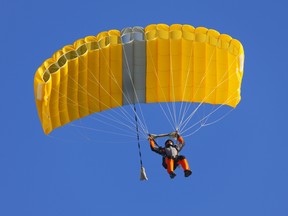Extreme Sports : Rare But Extreme Landings
"I'm heartbroken, because we never got to go on our Bali trip together like we always talked about, but also at an eerie ease knowing that you finally got your answer as to what an afterlife looks like.""You were one in a million and went out like a one in a million would...""Wait for me on the other side.""She was one of the bravest girls I ever had the chance of meeting and seeing her reach such a big audience in her last years of life, talking about things she genuinely cared about and loved was truly amazing."Kimia Sepanlou, Instagram post"It's like any other thing that we do in life, you know, whether you're mountain biking or driving race cars or water-skiing. I mean, there's always an inherent risk with what you do.""When you look back 20, 30 years ago, at the injuries and fatalities, and then you look a what's happening now, it's a difference of night and day [extreme sports' improved safety record].""It's the thrill, the excitement. Some people climb mountains, some people slackline or highline.""You know, some people hang glide. We skydive."Rob McNeill, member technical safety committee, Canadian Sport Parachuting Association
 |
| Wisconsin Sky Diving Center |
A 21-year-old philosophy student at University of Toronto, and TikTok influencer, Tanya Pardazi, last weekend fell to her death during a skydiving accident. This summer in Canada there have been at least four such fatal accidents, hers being the fourth to date. All of those accidents have taken place over a period of only three months. Three of those deaths took place in Ontario; in Niagara region a woman died in an "extreme fall" in July.
A search through news reports indicates that a similar number of sky diving deaths took place in 2021 as well. In Tanya Pardazi's case, an emergency during her jump led to her death; she attempted opening her parachute when she had already reached an altitude too low for safety, leaving insufficient time for the reserve chute to be deployed.
Fatalities resulting from skydiving are rare. The U.S. Parachute Association estimates 0.39 deaths per 100,000 jumps in the high-risk sport. Out of 1.5 million jumpers in 42 countries, according to the safety committee of the International Skydiving Commission in a 2018 report, 44 fatalities occurred that year; one the result of a tandem jump,\: two people jumping together, one of the two an expert.
According to the report, 61 percent of jump fatalities took place with "expert" skydivers, and just nine percent were students. "This not young novices and beginning jumpers getting hurt anymore. It's the experienced people", noted Rob MacNeill. Statistics verify that 68 percent of fatalities occurred as a result of human error.
Jeffrey Dean, 45, and a firefighter -- an accomplished skydiver with over 4,000 jumps to his credit -- died attempting an advanced manouvre. He was considered an "icon" in the skydiving community. What led to his death was not malfunctioning equipment; he died on landing. "[Dean] deployed [his] parachute without incident. The parachute was fully functioning, working correctly.
"Fatal injuries were sustained during the landing process following an advanced parachute manoeuvre", read a statement from Parachute Ottawa, the skydiving company Dean was jumping with at the time. The International Skydiving Commission feels of the 44 deaths, a dozen were related to landing issues, either intentionally fast landings or another type of error in landing.
Another six occurred resulting from a free-fall collision, an additional six from a medical issue, and five the result of equipment entanglement. Other identified causes such as a death from a reserve chute failing to deploy, one drowning death, and one collision with an aircraft.
"[86 percent of skydiving deaths were because of human error; jumping from an airplane, skydiving is an] inherently dangerous activity.""The mishaps typically stem from using incorrect emergency procedures, failing to deploy the parachute at a reasonable altitude, landing errors, and mid-air collisions.""Skydivers must often act under extreme time pressure while experiencing a state of high anxiety and arousal. These factors are known to contribute to human error in other domains."Paper, Journal of Human Performance in Extreme Environments
 |
| “The reality is that the vast majority of skydiving accidents are a result of simple human error,” the United States Parachute Association says on its website. Photo by iStock/Getty Images |
Labels: Equipment Failure, Extreme Accidents, Extreme Sports, Human Failure, Inherently Dangerous, Sky Jumping

0 Comments:
Post a Comment
<< Home